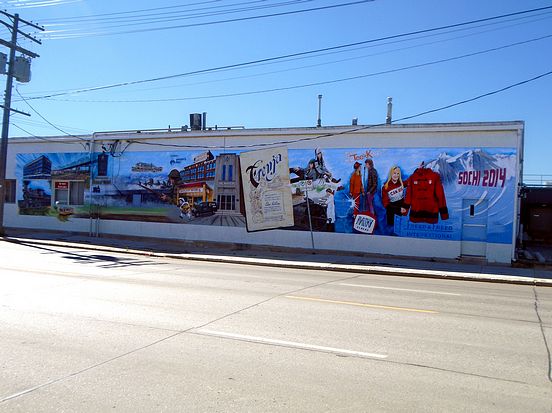|
|
|
|
|
|





|
|
812 Wall Street
Location Map

'Winnipeg's Newest Industrial Center.'
This 85 Feet long wall commemorates industry past and present in the West End.
|
Location: SW corner Wall & St. Matthews; North Face
Occupant: Auto Parts Central
District: West End
Neighbourhood: Minto
Artist(s): Dave Carty, Tom Andrich (Eclectic Fine Art)
Year: 2016
Sponsors: West End BIZ
|
|
|
Mural Walkthrough Notes from Dave Carty:
Reading from right to left the Mural begins (Photo 2) with Freed and Freed (1923) International,
a multinational garment manufacturer that has its early beginnings and roots in
Winnipeg`s famed garment industry. The Mural illustrates one of Freed`s many
successes with this home grown garment manufacturer when they produced all the
sportwear for Canada's athletes participating in the 2014 Sochi Olympics, Russia. Next
to Freed and Freed is another player in Winnipeg`s garment industry, Monarch Ware.
Although this company no longer exists it was once an international player with their
'Tee-Kay' brand that received trending support in the Pop Music world of the 1960's
and 70's. Two other prominent garment manufacturers are noted to be West End
businesses, Crown Cap (1934) on Wall Street and MWG, Mid-West Garments (1948)- both
of Winnipeg and both serving the international community. Crown Cap is said to hold a
very large share with the world`s hat suppliers and related accessories, including high
fashion gloves and handbags.
Below the Crown Cap depiction is an early off-set press
representing some of Winnipeg`s original West End printers such as Hignell Printing as well
Standard Machine Works (1911), a millwright/machine shop for railway and aerospace
industries still found on St Matthews Avenue. The press leads into a large cover publication
called 'Freyja', Canada`s first women`s suffrage publication. This was produced by the
early and prominent women`s rights advocate, Margaret Benedictsson. She was of
Icelandic descent and lived for a period on Sherbrook Street in Winnipeg.
To the left of the "Freyja" document is the early Monarch Industry building (Photo 3), a manufactuer of pumps
(1934). The Christie Biscuits building (1932) still adorns Notre Dame Avenue today and was a
producer of cookies, biscuits and the like for Canada's western provinces. The name
still lives on today under the Nabisco label. Below Christies is an early Canada
Safeway store. At the time Safeway had its Canadian head office in Winnipeg`s West
End on Pacific Avenue (1929). There are a number of these early Safeway store facades
still found throughout Winnipeg today. The station wagon vehicle below the Safeway
store is that of another West End industry that served Western Canada. Canada Bread,
although it was part of the Weston Bakery company out of Toronto, had a large bread
producing facility in the West End on Burnell Street (built 1911).
The Minto Armory is still located on St. Matthews Avenue and is home to the Royal
Winnipeg Rifles. The Rifles have served and fought with distinction in many battles
since its inception. The one illustrated in the Mural is from the 'D Day' Juno Beach
landing, 'Operation Overlord' of WW2. Directly above it is a depiction of the actual Minto Armory.
Past the Minto Armory is a memorial stone commemorating Canada's first Royal
Canadian Legion branch, Branch #1, which was situated on Sargent Avenue but has since
ceased operations. Following this is the Arlington Bridge that has had a colourful
Winnipeg past and an uncertain future. It also, along with the locomotive depicted, is
representative of Winnipeg's storied railroad history. The 'Countess of Dufferin',
Western Canada's first locomotive served the Prairies for many years. Below and to the
right of the railway engine is a modest street car, which were at one time, numerous in
Winnipeg's West End. Finally atop of the locomotive is the Ford Assembly Plant which
operated between 1916 and 1941, and supplied much of western Canada with
automobiles- in particular the model T.
|
|